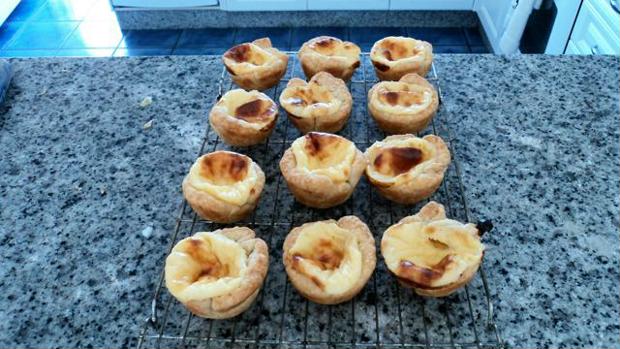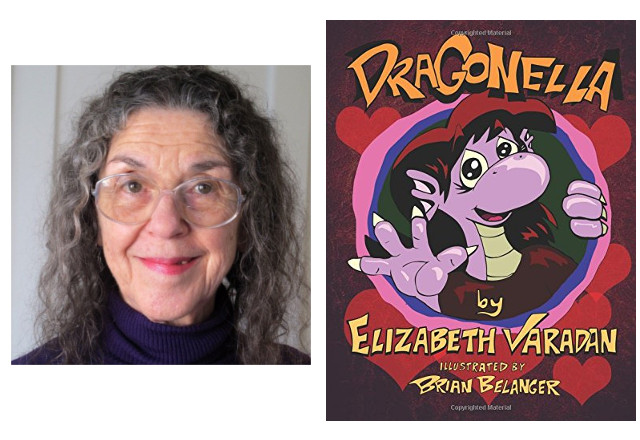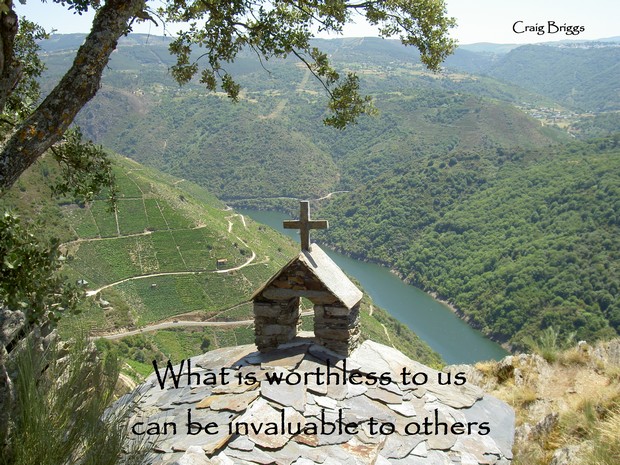
Note from the editor – This week’s Some-day Supplement will make you feel on top of the world with a trip to Castro Caldelas and with less than fifty days until Christmas we bring you a gift idea when we interview Elizabeth Varadan author of Dragonella – a children’s bedtime story with an important message. But first …
---------------------------------------------------------------------------------------
Canabal Cuisine presents – Portuguese Tarts
Ingredients
- 1 large egg
- 2 egg yolks (large)
- 115gms caster sugar
- 2 tablespoons cornflour
- 400ml full fat milk
- 2 teaspoons vanilla extract
- 1 sheet ready rolled puff pastry

Method
- Lightly grease a 12-hole muffin tin.
- Pre-heat the oven 200°C
- Put egg, egg yolks and cornflour in a pan and mix well. Gradually add the milk until the mixture is smooth.
- Place the pan on a medium heat and stir constantly until the mixture thickens and comes to the boil.
- Remove pan from heat and add sugar and vanilla extract. Adding the sugar at this stage prevents the custard from burning. If the mixture goes lumpy you can rescue it by blending it with a hand blender.
- Put the custard in a bowl and cover with cling film to prevent a skin forming.
- Cut the pastry sheet into two pieces and place one on top of the other. Roll the pastry into a log and cut into 12 even sized pieces.
- On a lightly floured board, roll each piece into a disc. Press the pastry discs into the muffin tin.
- Spoon in the cold custard.

- Bake for 20-25 minutes.
- Leave to cool in the tin for 5 minutes and then finish cooling on a wire rack but if you’re like me, you won’t be able to wait that long.

---------------------------------------------------------------------------------------
TRAVEL
Castro Caldelas – Feeling on top of the world
History, romance, and outstanding scenery, Castro Caldelas has it all. The next time you’re visiting the Ribeira Sacra in the heart of Galicia, make sure to spend a weekend in this charming inland town.

The drive from Monforte de Lemos to Castro Caldelas is one of the most spectacular in the area. It heads south along the LU-903 to the village of Doade. Staring out across the valley, the town of Castro Caldelas is clearly visible on the other side of the canyon of the river Sil. From Doade the road drops steeply down the side of the gorge, twisting and turning as is carves a route through terraced vineyards.

The scenery across the river is very different. Ancient woodlands cling to the side of the valley. Vineyards are sparse, restricted to a few south-facing patches of land. As the road climbs it passes through the picturesque villages of A Abeleda and O Pomar.
The focal point of the town is the main square, Praza do Prado. On one side of the square is the impressive twin towered 19th century Santuario de los Remedios. On the opposite side, towering over the urban landscape are the ramparts of the medieval castle.

Legend has it the town was named following a military defeat. The ruler of the ancient castro (fortress) surrendered his reign to the Lord of Lima and to save himself and his family from certain death he offered the Lord one of his three daughters as a prize. The Lord asked ¿cal delas? (which one of them). From that day forth the place has been known as Castro Caldelas.
Legends aside, this mountainous area has been inhabited for over 4500 years: a fact supported by the discovery of megalithic burial chambers. During the Roman occupation, between 137 BC and 19 BC the town became an important stopover on the Via Nova (The Roman road from Braga in Portugal to Astorga in Castile & Leon).

The castle was built between 1336 and 1343 by Pedro Fernández de Castro. Its strategic importance can be gauged by the numerous coats of arms above the entrance: the Osorio (two wolves), the Castro (six circular forms), the Kingdom of León (a rampant lion) and the Kingdom of Castile (a castle). Even the Greek letter tau, symbol of the Order of the Knights Templar, is inscribed on the clock tower.

Views from the castle ramparts are stunning, mile after mile of rolling hills, deep valleys, and distant mountains fading into an endless sky. From the clock tower on one side to the keep on the other, every aspect affords outstanding views over the Ribeira Sacra and the Sierra de Mazaira mountains.
The torre or keep, houses the oldest written document in Galicia. Dated 1228 and signed by Alfonso IX, it granted certain privileges to residents of the town. Its discovery was extremely significant as all other historic documents were destroyed in 1809 when Napoleonic troops set fire to the castle in retaliation for a local uprising.

The roof of the torre is probably the best place to appreciate the Iglesia de Santa Isabel (Church of St. Elizabeth). Dating from the 16th century, it’s the oldest church in the town and stands at the edge of an outcrop overlooking the canyon of the river Sil.
Today, Castro Caldelas is a quiet, friendly town with breathtaking views over the surrounding countryside but its long and turbulent history makes it a fascinating place to explore.
---------------------------------------------------------------------------------------
Author Interview
Elizabeth Varadan
Elizabeth divides her time between Midtown, Sacramento and the rural village of Trasulfe in Galicia, Spain. Elizabeth loves the written word.
“I can never leave a library or book store empty-handed and have been scribbling stories all my life.” she tells us.
Her work for children has been published in Story Friends and Ladybug Magazine, and Skipping Stones Magazine. Even though she writes mainly for young people, she has also had a number of short stories and flash fiction for adults published in various magazines.
Her most recent publication is Dragonella, a picture book, released by Belanger Books. It’s her third published book, the others being The Fourth Wish, a Middle Grade fantasy she self-published in the fall of 2008, Imogene and the Case of the Missing Pearls, a Middle Grade mystery set in Victorian England; involving Sherlock Holmes and published in 2015 by MX Publishing.

Elizabeth tells us more about Dragonella.
"Dragonella is the only dragon at her new school. Other students - trolls, griffins and ogres - are frightened when she breathes fire. The teacher isn't happy when Dragonella's laughter melts the filing cabinet. But when Dragonella's flames save the day during the class party on Legend Day, the teacher and other students learn they shouldn't be quick to judge someone who is different."
To order your copy of Dragonella or find out more about Elizabeth Varadan, follow these link: - https://www.amazon.com/Dragonella-Elizabeth-Varadan/dp/1978037821
http://elizabethvaradansfourthwish.blogspot.com
http://victorianscribbles.blogspot.com/
---------------------------------------------------------------------------------------
And now the moment you’ve all been waiting for - Question Time – this is when our roving reporter asks Elizabeth ten challenging questions.
1. If a movie was made of your life, who would play you and why?
I cannot imagine anyone making a movie of my life. And, at my age, they would probably have at least 4 different people play me. For the later years, I suppose Olympia Dukakis. I’ve always liked her (and she’s holding up pretty well.) For the “under 25” years, maybe Chloe Bayliss. She’s brunette. (The resemblance stops there.) As for the in-between years, your guess is as good as mine.
2. If you won a million pounds/dollar/euros etc, what would you buy?
I would donate a lot of it to various organizations that help others. Right now, a huge chunk of it would go to Puerto Rico. They still have contaminated water and no electricity. But there are so many areas of need, I would love to have that million and spread it around.
3. What is your least favourite thing about humanity?
Self-centeredness and greed. It seems the more people have these days, they still feel they haven’t enough. I’m always heartened by the people out there who are doing good and offer a counter-balance, so to speak. But it really repels me to see how in many cases, those who have the most don’t want to share any of it and seem chronically discontent.
4. If you were 80 years old and had children, what’s the most important experience you could pass on to them?
Advice? or Experience? If advice: Work hard, persevere, give thanks, be kind, and help others. We’re all in this boat called life together. If experience, I’d hope I’d had the chance to take them traveling, because travel broadens one’s life and enriches one’s understanding of people. I’d also want to make sure they had access to language lessons in at least one other language.
5. You’re a new addition to my spice rack, what are you and why?
Cilantro. It’s used in the cuisine of so many different cultures, and I love getting to know different cultures.
6. In fewer than 50 words, how does the internet work?
Um . . .
(You did say fewer than 50, and that does sum up what I can tell you.)
7. How can you tell if someone is a nerd?
Well, today’s “nerd” used to be yesterday’s “bookworm”, and it was easy to spot them, sitting apart, curled up with a book, oblivious to the hub-bub around them. Today? I don’t know. Everyone seems hooked to their smart phone, which is also their computer, their health monitor, their map, their appointment calendar, their messenger to FB, etc. I suppose the “nerd” is the one who really knows how to operate that thing beyond making routine phone calls.
8. If you could add one word to the dictionary, what would it be and what would it mean?
Splabulous. It means “splendidly fabulous”. The Spanish translation is “splabuloso.”
9. What undiscovered technology will transform the future?
A dimension machine. It will take you into other dimensions, so that you can find out what’s really going on outside of our three familiar ones. I’m secretly sure that’s where “ghosts” come from, along with those little gremlins who mislay your car keys . . .
10. What is the one thing you own you wish you didn’t?
Hmm. The fact is, everything I (we)) own has either a practical use or special memories attached, and I either like to use them, look at them, reminisce over them, or read them. I don’t really want to get rid of anything except when my bookshelves finally overflow, and then I take the excess books to the library or to a thrift shop.
---------------------------------------------------------------------------------------
And finally - #normalwisdom

---------------------------------------------------------------------------------------
This edition of the Canabal Chronicle, Some-day Supplement was brought to you by Craig Briggs, (with a little help from his wife Melanie) author of The Journey series of books.
